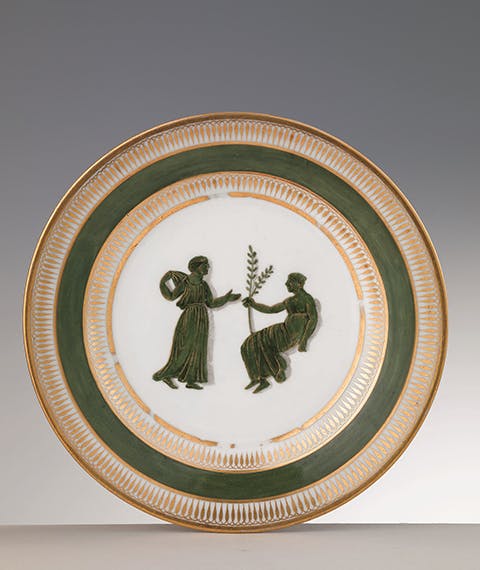Dishes for dessert set
Dagoty Factory, Paris; Ginori Factory, Doccia (restocking)
In red: “Manufacture / de S.M. l’Impératrice / P.L. Dagoty / à Paris”
Mark Gold star (Ginori Factory)
The “porcelain set decorated in the colours of Paris”, as described in the inventory of the Villa Reale di Marlia in Lucca, introduces us to a rich variety of decorations and is characterised by a common motif consisting of two green bands interspersed with threads and geometric elements executed in gold. At the centre of the dishes preserved in the Porcelain Museum there are various types of representations, two of which are of an antiquarian taste with figures in one monochrome ochre and the other green, in a shade close to that used for the band. It is a decoration in line with the taste of travellers on the Grand Tour and very common in the Dagoty Factory, where it was defined as "Etruscan" in reference to the derivation from the paintings of the Attic vases of Magna Graecia made known through the printed repertoires, such as the Antiquités Etrusques Grecques et Romaines tirés du Cabinet de Monsieur by Pierre d'Hancarville from 1766. Also in line with the decorative style of the French factory are the Dutch-inspired representations with forest landscapes in monochrome sepia animated by animals or men. These representations alternate with those in polychrome both with scenes of pastoral life, and with the reproduction of rare animals such as exotic birds taken from printed repertoires such as, for example, the Histoire naturelle, générale et particulière, avec la description du Cabinet du Roi by Georges-Louis Leclerc de Buffon from 1749-1789, from which the jaguar reproduced in sepia monochrome by the Doccia Factory on one of these plates was copied.
The parts that make up this sumptuous dessert set were originally one hundred and forty-two. In addition to saucers and trays, it was made up of four ice cream bowls, four sugar bowls (not traced), four risers, two of which are cup-shaped, sixteen composters and four fruit bowls modelled in the shape of baskets with feet. It was made by the Parisian Dagoty Factory at the request of the new Grand Duchess of Tuscany Elisa Baciocchi, who commissioned it in 1810 after her visit to the factory. The Factory was founded in Paris at the end of the 18th century by the three Dagoty brothers at Boulevard Poissonnière; Pierre-Louis Dagoty, who survived Isidore and Jean Baptiste Etienne, continued the business alone starting from 1801. At the 1806 Paris Industrial Exposition Pierre-Louis was awarded a silver medal, thanks to which he acquired imperial protection and his factory took the name of Manufacture de S. M. Impériale. This set was later integrated by the Ginori Factory in Doccia with three saucers still preserved in the Porcelain Museum of Pitti Palace, probably replacing the original ones that had been broken. It is likely that its restocking took place between 1820 and 1825, when it was still in use at the Villa Reale di Marlia in Lucca. From 1865 to today, the pieces found that made up the whole have been divided between the collections of the Porcelain Museum of Pitti Palace, the Medici Villa of Petraia in Castello (Florence), the Medici Villa of Poggio a Caiano and the National Museum of Capodimonte in Naples.
